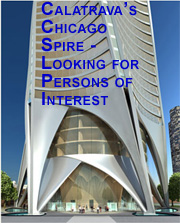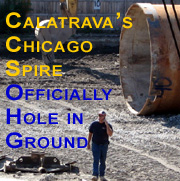
Santiago explains it all for you
 |
||||
|
Observations and Images on Architecture, Culture and More, in Chicago and the World. See it all here. |
||||
|
Santiago explains it all for you |
||||
|
|
-by Lynn Becker |
|
|||
|
|
[March 26. 2007] It's official. Chicago is in the throes of Spire-mania. Over 500 people packed two separate meetings on Tuesday to see and hear developer Garrett Kelleher and architect Santiago Calatrava present the proposed Cutting through the peninsula is Lake Shore Drive, a limited access highway. The Spire would rise to the west of the drive, linking under the drive to the long-unrealized DuSable Park to the east. While the Grant Park Advisory Council/Grant Park Conservancy, managed to upstage a previously announced session sponsored by the community group SOAR (Streeterville Organization of Active Residents), with their own lunchtime session, scheduled just last week, in the Grainger Ballroom of Symphony Center, in the last analysis the presentation there turned out to be something of a dress rehearsal for SOAR's event, where both Kelleher and Calatrava came alive to a level they hadn't earlier. Kelleher began with an arresting account of his journey from Ireland, to Chicago, where he eventually helped pioneer the conversion of the city's old loft buildings to residential developments, and then took his profits back to Ireland just in time for explosive growth in that country's economy beginning in the late 1990's, only to find himself moving back to Chicago again for a project of a lifetime. (We'll publish more of his talk later.) Then Calatrava sat down next to an overhead projector, explaining that the best way to explain the evolution of the Spire was "Just working as I work in my office, And then Calatrava began to make watercolor drawings. "You can think that the beginning was the lake," he said creating a single blue line at the bottom of the page, and he proceeded until all the elements of project were laid in a few simple, elegant and colorful strokes. Calatrava then layered several objects over each other - from the cross section of a shell to a bunch of flowers. "All these things," said Calatrava,
can be put into a "It’s like writing, or a poem, something like that. People understand things, with a magic that even if you close a book that you left in a library, 300 years later someone opens it and gets the book, because this language is understandable. More universal "If you go to the Church of Pantheon in Rome," continued Calatrava, "2,000 years are facing you, and still you can enter there, and you get moved by this very beautiful place. This is exactly the message that these people wanted to deliver. They wanted to move us 2,000 years later." We're still transcribing Tuesday's talks. There'll be a lot more - and a lot more pictures - in the next few days, especially a much fuller discussion of the plans for DuSable Park, as well as of some of the many still unanswered questions about the project. For the moment, here are just a few of images to come.
Calatrava presented a series of Matisse-inspired watercolors of the lifestyle to be found inside one of the Spire's apartments .
Calatrava's presentation ended with a spectacular aerial animation of the Spire, its plaza, DuSable Park , and a proposed pedestrian bridge across the Chicago River, from close-up to an extreme wide angle showing the Spire taking its place in the Chicago skyline. The animation was accompanied, appropriately enough, by Dvorak's 9th Symphony, From the New World, "played by the Chicago Symphony orchestra,” a smiling Calatrava added.
|
 
|
|||